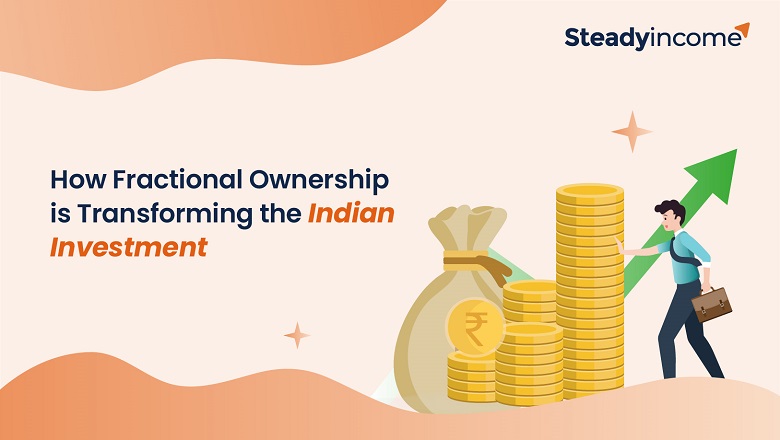How Fractional Ownership is Transforming the Indian Investment

The Indian investment ecosystem has undergone a significant transformation in recent years, moving from traditional instruments like fixed deposits and gold toward more sophisticated and diversified opportunities. One of the most promising and disruptive trends gaining traction is fractional ownership—a model that is democratizing access to premium investment assets like commercial real estate, luxury properties, and even collectibles.
Here, we will explore what fractional ownership is, how it works, and why it’s becoming a preferred strategy for savvy Indian investors looking for passive income, portfolio diversification, and lower entry barriers.
What is Fractional Ownership Investment?
Fractional ownership is an investment model where several individuals co-own a high-value asset by acquiring fractional shares or units. Each investor becomes a co-owner and receives returns based on their ownership share. Unlike traditional ownership, where a single buyer holds the entire asset, fractional ownership enables broader participation without massive capital outlays.
Why is Fractional Ownership Gaining Momentum in India?
1. Affordability and Accessibility
The real estate of the Indian investment market has historically been dominated by organised performers and high-net-worth individuals' investment. Fractional ownership platforms have removed entry barriers, allowing retail investors to access premium investment opportunities.
With minimum investments starting as low as ₹10–25 lakhs, fractional ownership provides an entry point to high-value assets that were once out of reach for the average investor.
2. Passive Income Potential
Assets acquired through fractional ownership—such as office spaces, warehouses, or co-living units—generate regular rental income. This creates a stable source of passive income for investors, especially when properties are pre-leased to reputable tenants. Additionally, investors can love capital appreciation as the property value grows over time, making it a dual-benefit investment avenue.
3. Professional Management
One of the key advantages of fractional ownership is that the asset is managed by professionals, be it property managers, legal teams, or financial advisors. Investors don't need to worry about tenant issues, maintenance, or compliance. This turnkey solution appeals to individuals who want returns without the hassle of direct ownership.
4. Diversification of Portfolio
Fractional ownership enables investors to diversify their portfolio by allocating capital across various assets and locations. For instance, an investor can co-own a commercial office in Mumbai, a warehouse in Bengaluru, and a co-working space in Pune. This diversification mitigates risk and optimizes return potential.
5. Regulatory Clarity and Technological Integration
India’s evolving regulatory environment and the integration of blockchain and digital contracts have increased transparency and trust in fractional ownership models. This has led to improved investor confidence and higher participation.
Key Sectors Benefiting from Fractional Ownership in India
-
- Commercial Real Estate: This is the most popular sector for fractional ownership. Grade-A office spaces, premium retail outlets, and modern warehouses deliver attractive rental returns along with strong long-term value appreciation.
- Vacation and Co-Living Properties: Luxury holiday homes, serviced apartments, and co-living spaces are gaining investor interest as they combine lifestyle usage with rental income.
- Commercial Real Estate: This is the most popular sector for fractional ownership. Grade-A office spaces, premium retail outlets, and modern warehouses deliver attractive rental returns along with strong long-term value appreciation.
Risk Factors to Consider
As with any investment approach, fractional ownership comes with risks:
-
- Liquidity Constraints: Unlike stocks or mutual funds, fractional assets can be relatively illiquid, although some platforms are building secondary markets for reselling.
- Market Fluctuations: Real estate and alternative assets are subject to market trends. Location, economic cycles, and demand can impact returns.
- Platform Reliability: The true potential of fractional ownership relies heavily on the trustworthiness and transparency of the platform, facilitating the investment.
- Liquidity Constraints: Unlike stocks or mutual funds, fractional assets can be relatively illiquid, although some platforms are building secondary markets for reselling.
To mitigate these risks, investors should conduct due diligence, read legal documents carefully, and choose SEBI-compliant or RBI-registered platforms when available.
The Role of Platforms like Steadyincome
At Steady Income, we understand that the modern investor is looking for secure, stable, and diversified returns. That’s why we offer curated fractional ownership opportunities backed by deep research, professional management, and end-to-end support.
Our investment solutions are designed to help investors:
-
- Earn consistent passive income
- Access premium, high-yield assets
- Minimize risk through structured ownership models
- Maximize returns with data-driven asset selection
Whether you are a seasoned investor or a first-timer looking for safe alternatives to traditional instruments, fractional ownership through Steadyincome can help you build a future-ready portfolio.
Final Thoughts
Fractional ownership isn't just a trend today, it's revolutionizing the way Indians approach in investment market. It empowers individuals to think beyond traditional options and explore alternative investments that offer higher returns, diversified exposure, and professional management.
As the Indian market matures and more investors seek low-risk, high-yield investments, fractional ownership is poised to become a mainstay in wealth creation strategies.

